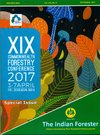Genetic Variation Studies in Natural Populations of Neoza Pine (Pinus gerardiana)
DOI:
https://doi.org/10.36808/if/2017/v143i9/118902Keywords:
Neoza-Pine, Populations, Heterozygosity, Polymotphic, Genetic Distance.Abstract
The genetic variation of Neoza pine (Pinus gerardiana) populations with restricted distribution confined to arid regions of the temperate Himalayas was studied. These populations located in Kinnaur and Chamba districts of Himachal Pradesh showed difference with regard to both quantitative and qualitative traits. The performance of selected individuals (Plus Trees) within populations showed significant differences for nursery traits. The evaluation of twelve populations of Noeza pine through isozymes using six enzyme systems recorded 14 gene loci of which 6 were polymorphic with 2-3 alleles per locus. Of the 16 alleles found encoded for 6 polymorphic gene loci, SKDH-A3 was rare for its observance in only two populations with one per cent frequency. The differences were observed among populations allelic and genotypic differentiation between and within gene loci among populations, heterozygosity and genetic distance. The mean heterozygosity value varied from 0.17 to 0.21 for population 9 to 1, 5, 6 and 11. Genetic distance values ranged from 0.009 between populations 6 and 10 to 0.039 between populations 3 and 12. The pattern of grouping for nearly the same values of diversity and differentiation among the populations despite altitudinal differences suggest common descent of the populations. The populations with greater genetic diversity values need to be conserved and made use of in future tree improvement programmes of the species.References
Cheliak W.M. and Pitel J.A. (1984). Genetic control of allozymes variants in mature tissues of White spruce trees. J. Hered., 75: 34-40.
Champion H.G. and Seth S.K. (1968). A revised survey of the forest types of India, Govt. of India, Delhi.
Conkle M.T., Hodgskiss P.D., Hunnally L.B. and Hunter S.C. (1982). Starch gel electrophoresis of conifer seed: A laboratory manual. USDA Forest Service General Technical Report PWS-64, 18 p.
Dogra P.D. (1964). Gymnosperms of India-II. Chilgoza pine (Pinus gerardianaWall.) – Bulletin of the National Botanic Garden, 109: 446.
Hamrick J.L. and Godt M.J.W. (1989). Allozyme diveristy in plants. In: Plant population genetics, breeding and genetic resources (Brown et al., ed.). Sinauer Associates, Sunderland, M.A., 43-63 pp.
Hamrick J.L., Linhart Y.B. and Mitton J.B. (1979). Relationships between life history charactersitics and electrophoretically detected genetic variation in plants. Annu. Rev. Syst. Ecol., 10: 173-200.
Hamrick J.L., Godt M.J.W. and Sherman-Broyles S.L. (1992). Factors influencing levels of genetic diversity in woody plant species. New Forests, 6: 95-124.
Loveless M.D. and Hamrick J.L.(1984). Ecological determinants of genetic structure in plant populations. Annu. Rev. Ecol. Syst., 15: 65-95.
Negi,S.S. (2002).Chilgoza of Neozapine-Animportant NTFP of the Traibla Areas of Kinnaur,H.P. J.Non-Timber Forest products,Vol.9(1/2):70-72.
Shaw C.R. and Prasad R. (1970). Starch gel electrophores is of enzymes: a compilation of recipes, Biochem. Genet., 4 : 297-320.
Squillace A.E. (1966). Geographic variation in slash pine Forest Science Monograph 10, Society of American Foresters.
Downloads
Downloads
Published
How to Cite
Issue
Section
License
Unless otherwise stated, copyright or similar rights in all materials presented on the site, including graphical images, are owned by Indian Forester.





